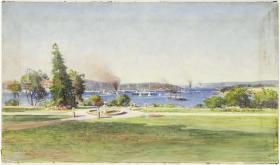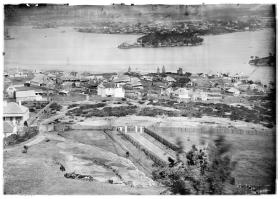Libby Hathorn presents poets of Australia: Dorothea Mackellar
Key inquiry question #1
Libby Hathorn's Poets of Australia - Dorothea Mackellar
Key inquiry question #2
Dorothea Mackellar's My Country
Key inquiry question #3
Dorothea Mackellar, writer, 1927, photograph by Moore, May, 1881-1931
Key inquiry question #4
Glass plate negatives of Sydney Harbour from the Holtermann residence, St. Leonards, 1870-1875
Key inquiry question #5
Vineyard, Castle Hill 1927
Key inquiry question #6
Picnic at Mrs Macquarie's Chair, 1855
Key inquiry question #7
Sydney Harbour, 1900
Key inquiry question #8
Photograph album of the employees and inhabitants of the Coolangatta Estate, Shoalhaven River, N.S.W.
Key inquiry question #9
Sydney street life, harbour and beach scenes, domestic animals, ca. 1880s-1900
Key inquiry question #10
Civil Ambulance & Transport Brigade of New South Wales
Featured content
Text type
- Narrative: poetry
Background notes for teachers
Learning intention
Students are learning:
-
To use language to shape and make meaning according to purpose, audience and context
-
To think in ways that are imaginative, creative, interpretive and critical
Success criteria
Students will be successful when they can:
-
Analyse the writing of Dorothea Mackellar and create a poem using inspiration similar to what she used
-
Learn and recite a verse of Dorothea Mackellar's poem 'My Country'
Background information:
Dorothea Mackellar was born in Point Piper, Sydney in 1885 and died in 1968. Though Dorothea was born in Sydney, her family owned various properties in the country near the Hunter Vally and Gunnedah. Dorothea would often visit the properties. It was her affinity to the land that would be her inspiration for 'My Country'.
'My Country' is one of the most well known and loved Australian poems. Dorothea wrote it at age 22 while she was living in England and missing her home country. It is considered THE quintessential Australian poem. It was first published in the London Spectator on 5 September 1908 and was titled 'Core of My Heart'. The poem was later renamed 'My Country' when it was published in a book of her poetry called 'The Closed Door, and other Verses'.
The 1908 published version can be viewed on Trove.
UNESCO 6:
Dorothea Mackellar’s poem, ‘My Country’ is listed on the UNESCO Memory of the World register. The register recognises and protects heritage documents that are significant for Australia and the world. For further information click here.
Useful websites:
The Australian Dictionary of Biography is Australia's most important dictionary of national biography. In it you will find concise, informative and fascinating descriptions of the lives of significant and representative persons in Australian history. For further information click here.
I Love a Sunburnt Country by Trevor Knight based it on Dorothea McKellar's iconic poem 'My Country’. Watch it here.
My Country (I love a sunburnt country). Watch it here. Words adapted from the poem My Country by Dorothea Mackellar, music by Tony Hatch and Jackie Trent, arranged by David Lawrence (1982). Origin of audio track uncertain.
Useful Resources:
Australian Dictionary of Biography published online
The ABC Book of Australian Poetry: A treasury of poems for young people compiled by Libby Hathorn
Classic Australian Poems Edited by Christopher Cheng
60 Classic Australian Poems, with commentaries by Geoff Page
The Penguin Book of Modern Australian Poetry edited by John Tranter and Philip Mead
My Country by Dorothea Mackellar
The love of field and coppice
Of green and shaded lanes,
Of ordered woods and gardens
Is running in your veins.
Strong love of grey-blue distance,
Brown streams and soft, dim skies
I know, but cannot share it,
My love is otherwise.
I love a sunburnt country,
A land of sweeping plains,
Of ragged mountain ranges,
Of droughts and flooding rains.
I love her far horizons,
I love her jewel-sea,
Her beauty and her terror
The wide brown land for me!
The stark white ring-barked forests,
All tragic to the moon,
The sapphire-misted mountains,
The hot gold hush of noon,
Green tangle of the brushes
Where lithe lianas coil,
And orchids deck the tree-tops,
And ferns the warm dark soil.
Core of my heart, my country!
Her pitiless blue sky,
When, sick at heart, around us
We see the cattle die
But then the grey clouds gather,
And we can bless again
The drumming of an army,
The steady soaking rain.
Core of my heart, my country!
Land of the rainbow gold,
For flood and fire and famine
She pays us back threefold.
Over the thirsty paddocks,
Watch, after many days,
The filmy veil of greenness
That thickens as we gaze ...
An opal-hearted country,
A wilful, lavish land
All you who have not loved her,
You will not understand
though Earth holds many splendours,
Wherever I may die,
I know to what brown country
My homing thoughts will fly.
Student Activities
Who is Dorothea Mackellar?
Students will learn about who Dorothea Mackellar is and her influence on Australian literature.

My Country
Students learn about the poem 'My Country' written by Dorothea Mackellar, and write their own poem inspired by their local area.

NSW Syllabus for the Australian Curriculum: English K-10
A student:
- EN3-CWT-01 plans, creates and revises written texts for multiple purposes and audiences through selection of text features, sentence-level grammar, punctuation and word-level language
- EN3-UARL-01 analyses representations of ideas in literature through narrative, character, imagery, symbol and connotation, and adapts these representations when creating texts
Students will:
EN3-CWT-01
- Select and use poetic forms to descriptively express ideas
EN3-UARL-01
- Analyse how figurative language in literature can enhance meaning and affect the audience
- Recognise recurring and universal symbols and imagery in literature, describe their meanings and experiment with symbol and imagery when creating texts
- Identify and describe messages common to lived experiences that recur in literature and use these representations when creating texts
- Explore how perspective is influenced by personal, social and cultural contexts
In each year of Stage 3, students must study examples of:
- spoken texts
- print texts
Across the stage, the selection must give students experiences of:
- Texts which are widely regarded as quality literature
- Widely defined Australian literature, including texts that give insights into Aboriginal experiences in Australia
- Wide range of literary texts, including poetry, drama scripts, prose fiction and picture books
General Capabilities
- Creative and Critical Thinking
- Literacy